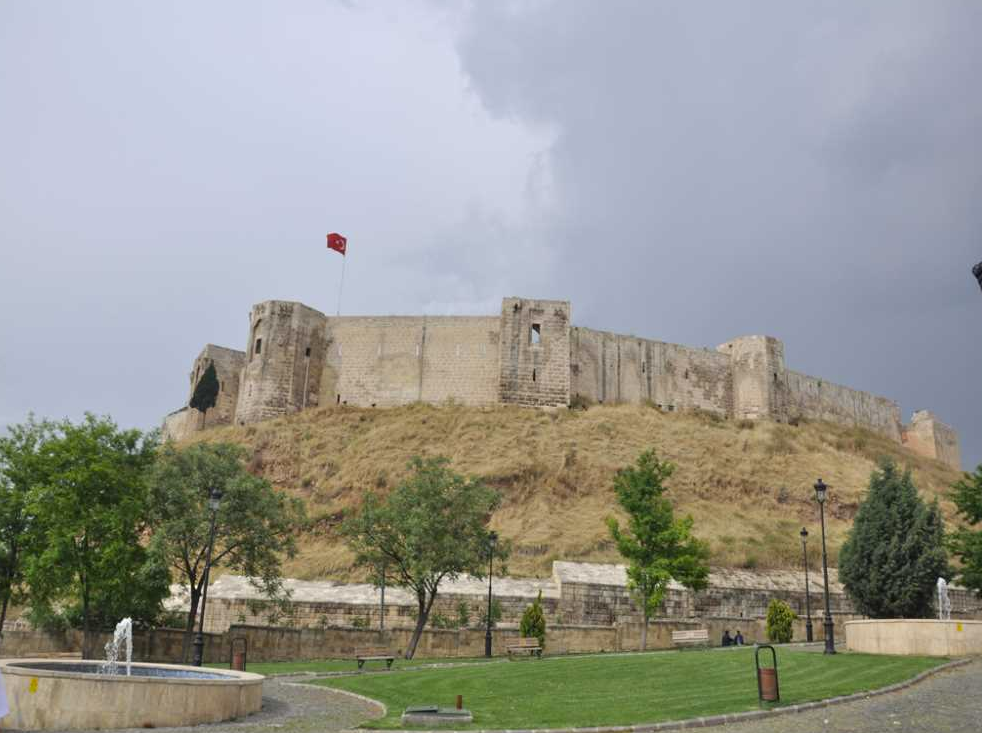Gaziantep Castle is an impressive structure located in the southeast of the city center, rising on the banks of the Alleben Stream. While the exact construction date of the castle is unknown, excavations on the mound where the castle is located indicate that the history of the region dates back to ancient times. Remains from the 2nd and 3rd centuries A.D. reveal the earliest signs of Roman settlement. Initially used as a watchtower by the Roman Empire, the castle expanded its function over time and underwent significant restoration during the reign of Byzantine Emperor Justinian I (A.D. 527-565). During this period, the castle became not only a military structure but also an important defense point to ensure the safety of trade routes in the region. The castle's current architectural form was shaped during this Byzantine period.

Gaziantep Castle (Source: Kültür Portalı)
Architectural Structure
Gaziantep Castle is a dazzling structure, particularly with its circular shape and carefully constructed towers. The castle contains a total of 12 towers, each serving different functions. In his Seyahatname, Evliya Çelebi mentions the castle's 36 bastions, describing their connections and strategic locations. However, over time, many of the bastions were destroyed or damaged, and today, only 12 bastions remain intact. These towers serve a dual purpose of providing defense within the castle and connecting various rooms and passages. The castle is surrounded by a moat approximately 180 meters in length. This moat was designed to enhance the castle’s defensive capabilities, and entry to the castle is provided via a bridge. One of the most prominent features of the castle is the incorporation of structures and repairs from different periods. The Byzantine, Mamluk, Dulkadirids, and Ottoman periods each left their marks on the castle, with various repairs and additions made throughout history.
Archaeological Findings
Archaeological excavations at Gaziantep Castle have revealed significant finds both inside and around the castle. Excavations carried out in 2000 uncovered the remains of an Ottoman mosque and bathhouse. The bathhouse, both structurally and technically impressive, reflects the engineering achievements of the Ottoman period, with its bath, steam rooms, and chimneys. Additionally, the mosque remains are in the style of Ottoman architecture and feature a rectangular plan. The mosque's mihrab, book niches around it, and the pulpit illustrate the aesthetic understanding of religious buildings from the period. Furthermore, numerous ceramic fragments, metal objects, coins, and weapon parts dating back to the Byzantine and Ottoman periods have been discovered during the excavations. These findings prove that Gaziantep Castle was not only a military fortification but also a social and commercial hub.
Restoration Works
The restoration process of Gaziantep Castle has gained significant momentum in recent years. Since 1989, excavation and restoration works have been initiated by the Ministry of Culture and Tourism and the Gaziantep Special Provincial Administration to preserve the structural integrity of the castle. During the restoration, the surrounding area of the castle has been defined, and protective walls have been constructed. The castle walls have been repaired, dangerous structures have been cleared and made safe, and especially the area around the main entrance has been restored to its original form while maintaining its historical character. In addition, the water channels in the rooms and galleries inside the castle have been cleaned and restored to functional condition. The excavations and restorations carried out by the Gaziantep Archaeological Museum have both contributed to the preservation of the castle and made it possible for the historical value of the region to come to light.
Gaziantep Castle is not only a military structure but also holds great significance as a cultural heritage. The archaeological excavations have uncovered the historical transitions and traces of civilizations in the region. The findings from these excavations demonstrate that Gaziantep has historically been an important settlement and cultural center. The castle has become a symbol of the city and a major tourist attraction for both domestic and foreign visitors. Gaziantep Castle is an important document that narrates not only its architectural structure and history but also the cultural interactions and the history of the people in the region. By being structurally preserved, it offers visitors a historical journey, carrying the traces of the past into the future.

